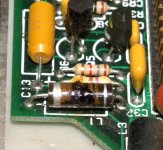SunDown79
Veteran Member
So as stated in the other post I am working on an Altos 886 and in it there was a big 5,25" full-height MFM harddisk.
Turns out its a Priam V150 that did absolutely nothing, which is rare for a drive, they usually make some noises.
So had a look at the PCB on the bottom, all seemed ok
Then removed all the screws and stuff to get to the PCB below that and was full of dust AND I saw that something on the corner had exploded but not sure what it was.
Anybody here perhaps have an idea ? Would be cool if I could just replace the part, clean it all up and perhaps still use the drive.
Pictures are here : https://flic.kr/s/aHsmTnfTQV
Thanks!
Stefan.
Turns out its a Priam V150 that did absolutely nothing, which is rare for a drive, they usually make some noises.
So had a look at the PCB on the bottom, all seemed ok
Then removed all the screws and stuff to get to the PCB below that and was full of dust AND I saw that something on the corner had exploded but not sure what it was.
Anybody here perhaps have an idea ? Would be cool if I could just replace the part, clean it all up and perhaps still use the drive.
Pictures are here : https://flic.kr/s/aHsmTnfTQV
Thanks!
Stefan.

